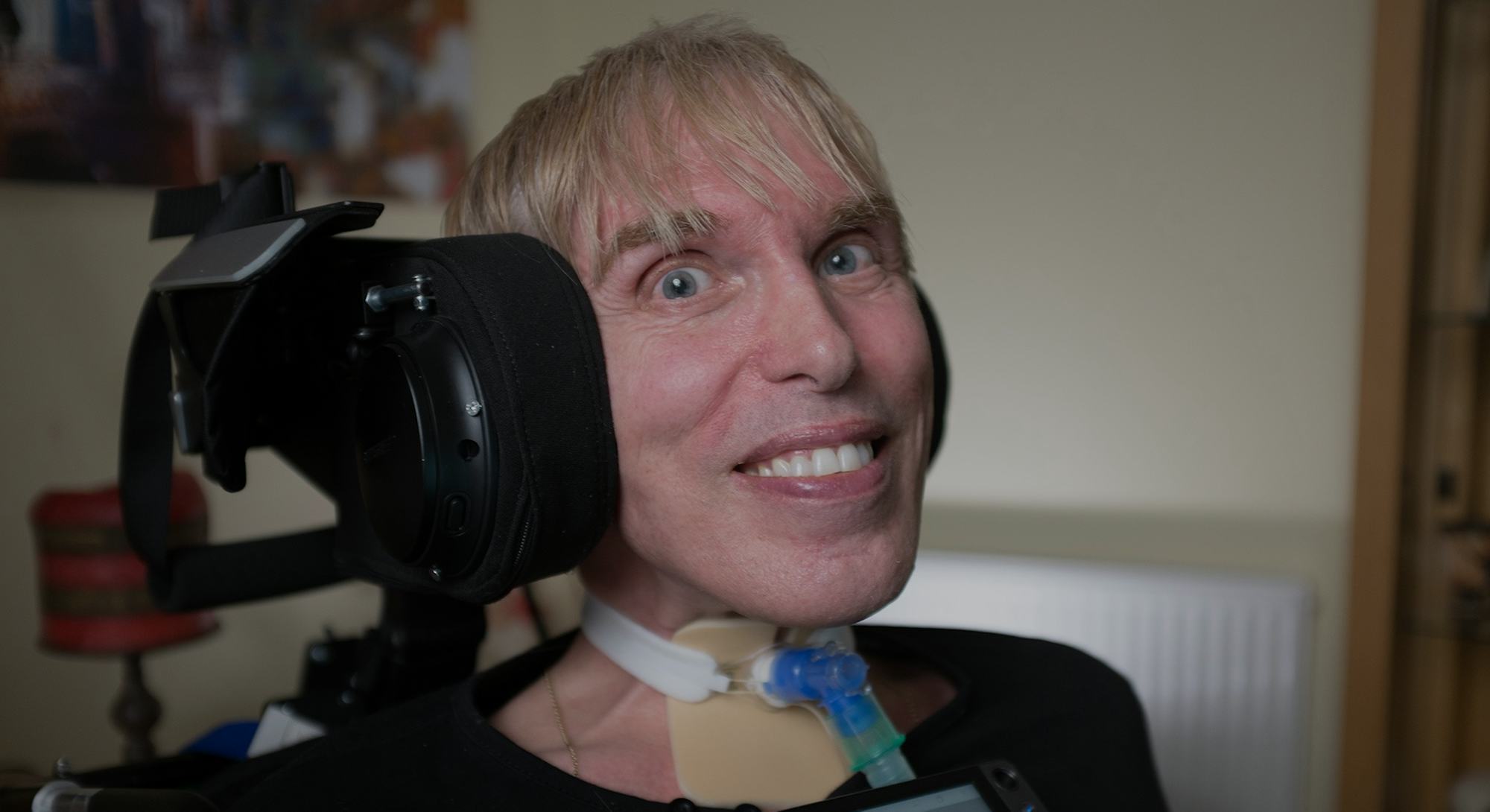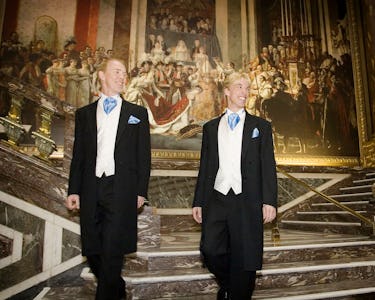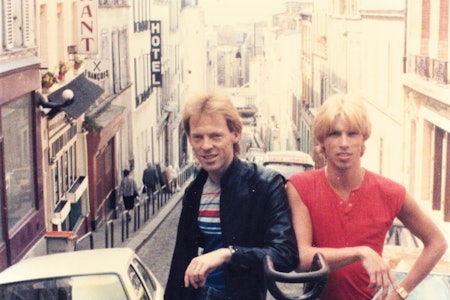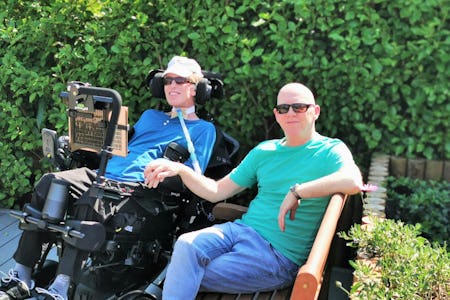New frontiers
After ALS struck, he became the world’s most advanced cyborg
Scientist Dr. Peter Scott-Morgan is pushing the boundaries of what it means to be human.

Dr. Peter Scott-Morgan, a prominent British-American robotics scientist, is almost completely paralyzed — save for his piercing blue-gray eyes, which are constantly in motion, typing out text to be spoken by his synthesized voice.
Scott-Morgan, who is 63, remains undaunted, though. “Paralysis is an engineering problem,” he insists, and it’s one he has a solution for: becoming a cyborg. “And when I say ‘cyborg,’ I don’t just mean any old cyborg, you understand, but by far the most advanced human cybernetic organism ever created in 13.8 billion years,” he says.
In 2017, Scott-Morgan was diagnosed with amyotrophic lateral sclerosis (ALS), also known as Lou Gehrig’s disease. His illness, called Motor Neurone Disease (MND) in Britain, is the same degenerative disease that afflicted physicist Stephen Hawking. Having spent equal periods of his career living in England and America, he now resides in Torquay, a seaside town in southwest England, with his husband Francis.
He’s been well-known in the U.K. since the 2020 release of a primetime Channel 4 documentary, Peter: The Human Cyborg, and his subsequent memoir, Peter 2.0. Here in the U.S., he is a more obscure figure.
ALS affects the motor neurons in the brain and spinal cord that tell muscles what to do. As ALS progresses, the degeneration of motor neurons in the brain interferes with messages to muscles in the body. Eventually, muscles atrophy, and people with ALS lose the ability to move their arms, legs, and body. They become unable to talk, walk, breathe, or swallow. Most die from respiratory failure within three to five years after symptoms first appear.
In 2017, doctors told Scott-Morgan that he had two years to live. So far, it’s been four — and he has no intention of dying anytime soon. Dr. Brian Dickie, director of research for the MND Association in the U.K., who is familiar with Scott-Morgan’s case, says the roboticist has what those in the terminal-disease world call “incurable optimism.”
Scott-Morgan doesn’t believe in God; he believes that technology will save him. “All my early science education came from Dr. Who and Star Trek,” he says. “They taught me that if you’re smart enough, brave enough, and have access to technology, anything’s possible.”
At this point, Scott-Morgan is almost completely “locked-in,” unable to move except for his eyes and a few facial muscles. His sense of smell and taste are gone, and he can’t breathe on his own, but his brilliant mind is fully intact.
Scott-Morgan now relies on a synthetic version of his biological voice and has had his face scanned to produce a 3D animated avatar, which he wears on a screen on his chest when speaking publicly. After a series of operations to extend his life, including a total laryngectomy, he uses technologies like GPT-2, OpenAI’s generative deep-learning model for text, pushing the boundaries of what it means to be human.
He’s done all this with a global consortium of technologists, designers, and physicians. The Rebels, he calls them. His Scott-Morgan Foundation is collaborating with companies like Intel, CereProc, DXC, and Lenovo. They are working alongside leading scientists, engineers, artists, and technologists to provide hardware, software support, integration, and AI. They’re all donating their time and resources in an effort to pioneer better solutions for people living with extreme disabilities.
Exclusive video of Scott-Morgan speaking via his old and new avatarsPeter Scott-Morgan
The Rebels are working on advancing the ability to customize expressive digital voices, developing self-driving wheelchairs, and embedding smart technology throughout Scott-Morgan’s home.
“With extraordinary support from my husband, Francis, and countless kind and brilliant collaborators, I find the once-dark future incredibly bright,” says Scott-Morgan, whose ultimate goal is to control his synthetic voice, avatar, word predictor, self-driving vehicle, and exoskeleton through a single user interface. To do so, he plans to increasingly rely on AI.
“Cyborg is just a fancy word for part-human, part-machine,” he says. “Contrary to the torturous scare stories about how it feels to be trapped in your own living corpse, the brain moves on. It grieves a bit, and then, if you give it a chance, most of the time, it forgets. Days pass when I never once remember that I could walk, move, or absurdly, even that I could talk in the past.”
Scott-Morgan says he participated in the recent documentary about him to get a message of “thriving” out there to counter our culture’s defeatism around terminal illness. “Society just expects people like me to statistically curl up and die on cue,” says Scott-Morgan. “Instead, I intend to be a human guinea pig, to see just how far we can turn science fiction into reality.”
Locked-in
The first time I hear from Scott-Morgan, in July, he emails me a 111-page PowerPoint presentation for his foundation, which took him a month to complete using only his eyes. “Some days, I could only design two slides a day,” he writes.
One of Scott-Morgan’s slides describes a night when he couldn’t communicate an excruciating pain from a cramp in his foot. (Between 57 and 72 percent of patients with ALS report pain.)
Not long after, I wake up with a cramp in my own foot. At first, I think I’m having a nightmare, psychosomatically channeling Scott-Morgan’s pain. I can’t conceptualize the feeling of being locked-in and experiencing unmanageable suffering. For seconds, which feel like minutes, I try to calm my mind. I can't think my way out of the cramp, a fact that takes me a while to shake. If I couldn't manage the pain, how does Scott-Morgan?
The following morning, I email Scott-Morgan about my experience, worried about what it must be like for him. “To put this in perspective, temporarily losing the ability to use a hi-tech comms system — although potentially traumatic and painful — is infinitely preferable to not having the system at all and suffering the waking nightmare of being locked-in, trapped in impotent silence within the straightjacket of your own living corpse,” he responds.
“Fortunately, there is a well-established protocol for high tech,” he adds. He suggests I talk to Lenovo’s chief technology officer, Thorsten Stremlau.
“There are rare moments where you see the real power and potential of technology, where the possibilities both seem endless and essential.”
Lenovo is providing the intelligent hardware — smart cameras, eye-tracking headsets, and high-performance computing infrastructure — needed to realize Scott-Morgan's vision. “There are rare moments where you see the real power and potential of technology, where the possibilities both seem endless and essential,” says Stremlau when we connect via Zoom. “Meeting Dr. Peter Scott-Morgan was one of those moments.”
One of the earliest project teams Stremlau was part of at Lenovo aided Stephen Hawking with the IT setup for his wheelchair and laptop. Expanding on that work, Stremlau plans to use cameras and wearables to detect distress or elevated vitals in Scott-Morgan; the tech will alert his caretakers should he be unable to communicate because he’s not wearing a headset.
“These problems we solve for Scott-Morgan will help us advance the work we’re doing for people facing disabilities,” Stremlau says. “Ensuring that Peter has a way to communicate when he’s locked-in drives my commitment.”
Triple-ostomy
As a 16-year-old growing up in Wimbledon, England, Scott-Morgan wrote essays about how in the future, his human brain would link with an electronic brain, asserting that “together we will be far more intelligent than the sum of our parts.”
In 1984, he published The Robotics Revolution, a book about the future of robots, almost as if he knew he’d need a manual. Building on a bachelor’s degree in computing science, and a post-graduate diploma in AI, he earned a Ph.D. in robotics from the Imperial College of Science, Technology, and Medicine — the first such degree granted in England.
When Scott-Morgan came out as gay in the 1970s, everyone in his family, except his parents, disowned him. “The world told me, ‘You really don’t fit,’” he says. When the Citizen Partnership Act was enacted in the U.K. in 2005, Scott-Morgan and his partner, Francis, became the country’s first legally recognized homosexual couple. After the law was revised in 2014, the two were the first to officially marry there.

In 2017, just after being diagnosed with ALS, Scott-Morgan realized he’d need to act quickly to reengineer his body before becoming locked-in. He envisioned three surgeries: a gastrostomy, colostomy, and a cystostomy, which would insert tubes directly into his stomach, colon, and bladder, respectively. A “triple-ostomy” he called it. The surgeries would allow Scott-Morgan to take in more nutrients and avoid having to have a full-time caretaker to assist him in going to the bathroom.
The challenge was that no one with ALS had ever preemptively had all three surgeries, let alone requested them. Determined, Scott-Morgan and his husband met with the head of the ALS clinic at a major London teaching hospital to describe his plan. However, as Scott-Morgan recounts in his book, before he finished explaining his reasoning, the doctor interrupted him: “I refuse to become involved in any of this!”
“But I want to be proactive in my overall clinical care,” said Scott-Morgan.
“ALS follows no rules. You cannot be anything other than reactive,” said the doctor. “Plus, if we did that for you, we’d have to do it for everyone with ALS.”
Scott-Morgan processed this and sat in disbelief. Imagine rejecting individualized care, he thought. He fired the doctor and returned home to meet with his local National Health Service physicians doctors.
When Scott-Morgan explained the “triple-ostomy” to Tracy Thomas, his local ALS coordinator, she did not take well to the idea. “When I said I was going to throw a huge amount of cutting-edge technology at my disease to see how I can make being locked-in really exciting,” says Scott-Morgan, “she let me know that it would be a newly frozen hell before any surgeon on the planet would damage perfectly healthy organs.”
The plan was radical, and to further complicate the situation, most doctors are hesitant to operate on a patient with ALS because general anesthesia can impede breathing. Also, some physicians worry that surgery may trigger a more rapid progression of their disease.
Ultimately, Thomas was won over by Scott-Morgan’s enthusiasm to extend his life and organized a meeting with Dr. Maree Wright, a soft-spoken anesthesiologist based in his hometown. “When I first heard about Peter’s case, I thought, ‘Why would he want this really high-risk surgery?’ But you know,” says Wright via Zoom, “there’s only one Peter.” She lifts her hands and smiles. “He’s a trailblazer, and frankly, we need people that rock the boat to make us think and reflect on why we do things in a certain way.”
Wright was caught off guard by the passion and candor with which Scott-Morgan expressed his desire to live. It shook her views on how the medical profession approached the treatment of his disease. If she could help him, the implications for other ALS patients could be staggering.
However, first, she had to develop an anesthesia plan, and there was hardly any research data on how to anesthetize people with ALS. Her greatest concern was that Scott-Morgan might not be able to come off a ventilator after his operation. Hospital officials tried to talk Scott-Morgan out of having his surgery at the eleventh hour, but he was resolute in his decision to move forward.
Ultimately, Scott-Morgan’s team of physicians and his local NHS hospital made the bold decision to support his wishes and move forward with the landmark surgeries that would extend his life. On July 10, 2018, the three surgeries were performed by multiple surgeons over three hours and 40 minutes.
Everyone involved was surprised to see Scott-Morgan discharged to the general surgical ward after only a day in ICU and then sent home 15 days post-op. Scott-Morgan proudly points out that a medical paper about the procedure was selected as the Oxford Medical Case Report of the year for 2019.
Version 2.0
Immediately after his triple-ostomy, Scott-Morgan began planning his next surgery, a full laryngectomy to stop the risk of choking on his own saliva or not getting enough oxygen. It was another radical idea — one that would cost Scott-Morgan his voice box but prolong his life indefinitely.
Wright, Scott-Morgan’s anesthesiologist, helped him find the surgeon to do it: Dr. Philip Reece, a top ear, nose, and throat surgeon also based locally in Devon. Reece agreed with Wright that Scott-Morgan should be able to live as full a life as possible.
Before the surgery happened, Scott-Morgan set out to solve another problem — how to create a synthetic voice that sounded like him. He reached out to a world authority in speech technology research and development, Dr. Matthew Aylett, the chief scientific officer of CereProc, a company that creates text-to-speech solutions. Based in Edinburgh, Scotland, CereProc is the company that rebuilt film critic Roger Ebert’s voice following his throat cancer surgery.
“Because of new translation technologies, I will be able to swear in any language.”
Using a neural text-to-speech system called CereWave AI, Dr. Aylett created a digital voice that sounds very close to Scott-Morgan’s natural voice. CereProc reproduces emotion by asking speakers to read scripts in different ways — say in a calm or tense tone.
“If you lose your voice because of an illness like ALS, you want to sound like you,” says Aylett. “Synthetic-voice technology is evolving daily. From changes in algorithms to improvements in how we process and edit voice itself, it is becoming quicker, easier, and more efficient to create an artificial voice.”
As Scott-Morgan’s ALS progresses, he won’t be unable to form facial expressions, so he wanted a 3D animated avatar that could express emotions and be capable of speech. Aylett’s team worked with Scott-Morgan to record more than 15 hours of audio and more than 1,000 individual phrases to create the avatar.
On Oct. 9, 2019, Scott-Morgan tweeted what he said was his last post as “Peter 1.0.”
The following day, he struggled to say his last words to his partner — “I love you” — just before Reece performed the landmark preemptive procedure, the first-ever elective laryngectomy on someone with ALS in the U.K.
“Being able to speak with what is recognizably my voice, has totally taken the sting out of giving up my biological voice,” says Scott-Morgan. “Because of new translation technologies, I will be able to swear in any language,” he adds. “Shit! Merde! Scheisse!” His digital avatar can even sing, as demonstrated in a recent live interview with broadcaster Stephen Fry.
Scott-Morgan’s first-generation avatar couldn’t smile. His new AI-instructed avatar — created by Pinewood Studios, which digitally duplicated Carrie Fisher’s face for the latest Star Wars movie — will show his emotions, allowing him to laugh, smile, wink, and pull off his signature move: raising his right eyebrow. Currently, the challenge is real-time synchronization — so voice, lips, and expressions all work together to portray the same emotion — something we take for granted as human beings.
“My smile will be the last thing to disappear,” says Scott-Morgan. “I should have a new avatar just in time before I can no longer smile. They promise it will be indistinguishable from a real person, allowing me to convey emotion.”
AI system
Today Scott-Morgan is limited to communicating letter by letter, word by word, through a manual eye-tracking system. DXC is working with the Scott-Morgan Foundation and partners to develop a new context-aware AI system that will radically improve the verbal spontaneity of Peter 2.0.
The next iteration of the software will include a system that will learn from Peter’s previous interactions and offer him possible responses appropriate to his situation. (Before being locked-in, Scott-Morgan had laser eye surgery to give him perfect vision at 70 centimeters — the distance from eyes to his computer screen.)
Esther Duran, design and innovation director at the Scott-Morgan Foundation, collaborated with Lama Nachman, director of the Human & AI Systems Research Lab at Intel, to help Scott-Morgan communicate. Previously, Nachman and her team developed Intel’s Assistive Context-Aware Toolkit, a software platform that helped Hawking communicate through keyboard simulation, word prediction, and speech synthesis. They made it open-source so that developers could build different capabilities on top of it.
“I prefer to view the future through the lens of human–AI collaboration rather than human–AI competition.”
After Hawking lost the use of his hands, he started using a cheek muscle to communicate. Computers designed for him relied on running lists of words. Whenever the cursor reached a word or phrase he wished to use, Hawking twitched his cheek muscle to select it. The process was painstakingly slow — about one word per minute.
Nachman explains that extreme accuracy mattered to Hawking, so he wasn’t willing to give up control. “Whereas, if you look at Peter, he wants to have a natural interaction with people,” she says. “It’s not about wanting to sound exactly like Peter 1.0 before his diagnosis. He’s trying to meld with his AI to make Peter 2.0 the best combination of his personality and the AI.
“While much of the conversation around AI and humans positions the relationship between the two as adversarial,” she continues, “I prefer to view the future through the lens of human–AI collaboration rather than human–AI competition.”
The future
The next challenge the Rebels are tackling is motion, and they are recreating every element of both the mental and mobile human experience. DXC is helping to integrate Scott-Morgan’s AI to control his specialized robotic wheelchair, a sophisticated device that can “boldly go where no wheelchair has gone before,” as Morgan put it in a tweet.
“The development of self-driving wheelchairs has some clear first-mover advantages over cars,” says Sukhi Gill, DXC’s chief technology officer for Europe, Middle East, and Africa. “They operate mostly in known and controlled environments — think home, garden, park, and local store. They move a lot slower and have to contend with far fewer possible hazards. By applying some learnings and technologies from the automotive industry, the self-driving wheelchair represents a realistic mid-term goal for this project.”
Ever the optimist, Scott-Morgan says he envisions “being able to speed through an obstacle course or safely make my way through a showroom of porcelain vases.”
Meanwhile, says Jerry Overton, vice chair and director of AI at the Scott-Morgan Foundation, there’s an ongoing project to give Scott-Morgan the smartest home possible. “We are designing Peter's home as a network of home-automation devices and personal applications.”
This network includes smart thermostats, smart bulbs, motion sensors, cameras, his avatar, and messaging applications. “Finally, we are using a central artificial intelligence — nicknamed CHARLIE — to coordinate the network,” he adds. Overton offers an example of what would happen if Scott-Morgan's biosensors suggest that his body temperature is becoming too high: “CHARLIE can take the initiative to lower the room temperature and alert his healthcare providers that there may be a problem.”
It takes a rare person to serve as a living tech experiment. As I got to know Scott-Morgan, I continually asked myself if I could ever endure the exceedingly uncertain nature and psychologically harrowing experience of rewiring my entire persona.
I didn’t know. So I asked the person closest to Scott-Morgan what he thinks. “As things are today, I might not wish to stay alive as long as Peter has if I were to get ALS,” says his husband, Francis. “But I hope that if you ask me again in five years that my answer will absolutely be yes.”
The
following day, I receive an email from Scott-Morgan, who has obviously
heard about my question to Francis. The subject line reads “Love never
dies.” “Whatever Francis tells you (and tells himself) about not being
as brave as me, that is what is scientifically categorized as
‘bollocks’!” he writes. “Bravery isn’t about not feeling scared, it’s
feeling scared but going on regardless.

“Here’s how it would play out,” he continues. “If Francis ever felt like giving up, I would remind him (as he occasionally does to me) that that’s not what Scott-Morgans do. ALS is the ultimate bully, and we have never given in to bullies. I would reassure him that I would always be there, fighting by his side.”
The most extraordinary thing about Scott-Morgan, beyond his defiant optimism, is that he sees his diagnosis as a blessing, not a curse. “Without my ALS, Francis and I would have enjoyed ourselves but achieved little,” he says. “Now we may be able to help rewrite the future of what it means to be disabled. How do you weigh a trade-off as gargantuan as that?”
I realize that I’ve never known anyone so adamantly alive. His closing words speak to what inspires all the Rebels. “Ultimately, however uncertain Francis may feel now, I am not in the least uncertain — for one very simple reason,” writes Scott-Morgan. “If there is one thing that is certain in my universe, Francis would never voluntarily leave me alone. Any more than I would him.
“I am a prime candidate for the fast track to death, but I will pass on the offer,” he adds. “I am frankly far too busy having fun.”


No comments:
Post a Comment